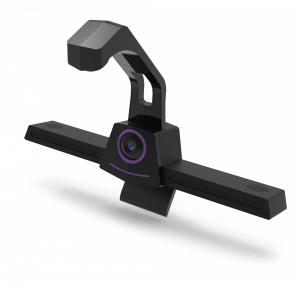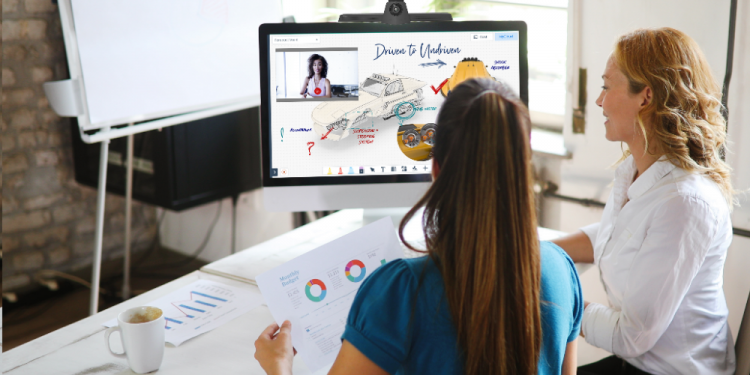The most important, if not indispensable, transformation that the post-pandemic world is going through is the hybrid working set-up, with a mix of work from office, and home provisions. However, it wouldn’t be as fancied as it sounds. For a simple reason that it does have its own limitations, and organizations need to have certain measures in place to be successful with the model- writes RAMYA CHATTERJEE, CEO of Cybernetyx, the leading developer of perceptual AI-devices and solutions for learning and working spaces.
……………………………………………………….…
 The pandemic brought the whole world to a standstill. It made us rethink our working patterns. The functioning of industries and organizations has taken a drastic turn. It made way to the future of working culture – the hybrid working setup.
The pandemic brought the whole world to a standstill. It made us rethink our working patterns. The functioning of industries and organizations has taken a drastic turn. It made way to the future of working culture – the hybrid working setup.
Gartner Survey reveals that 82 per cent of organization will allow employees to work in a hybrid way where they can work from home and office in a flexible schedule. While this practice has an array of advantages, it does come with a set of limitations as well.
Employees face greater distractions when working from home, thereby causing hinderance to their productivity. Shortage of quality equipment adds to the burden of getting work done in time. The absence of an IT support staff causes delay in addressing the technical glitches. Employees are facing zoom fatigue because of prolonged video calls and meetings. The process of sitting in one place the entire day and only talking and listening to people though a device is a tiresome task.
Here are a few tips for an organization to support and enhance remote working.
1) Video quality is key – The constant effort to look good during a client meeting or a presentation has been of utmost concern to the employees. This causes distraction from the actual purpose of the session. Working in suboptimal conditions like these makes them worry about the slightest things like their appearance. The quality of video can make or break the presentation while connected remotely.
Solution – A camera that focuses and frames you even when you are not seated at the exact center of the lens makes the meeting experience hassle-free. The camera should be able to enhance your video quality even when you are presenting in a dim light. With features like these, an intelligent camera comes as a savior while presenting important ideas remotely.
2) Sounding good is top priority – Working from home is undoubtedly not as calm and peaceful as working in office. There is always a television running in the background, with pressure cookers whistling in the kitchen and a truck unloading goods on the street. All these affect the quality of audio while you are in a meeting. It creates a lot of disturbance thereby degrading the quality of the session.
Solution – The quality of audio is more important than a video. What you say needs to be heard clearly irrespective of your video quality. A noise cancelling microphone will make this possible. All the noise around you will be deleted and the microphone will focus only on your voice even when you are seated at the farthest end of the room. Scrum meetings, project edit calls, team meetings can all be audio-only sessions. Team members can each be given a chance to voice their opinions on the project thereby increasing the engagement of the team as a whole.
 3) Visual Collaboration towards a common goal – There has been a huge limitation with meetings being conducted online. Employees face difficulty to explain their ideas without their usual go-to tools like whiteboard or marker boards. Because of this, team meetings have become only about the 2-3 people who actively participate on a call, while the rest just sit through the entire meeting without much interaction, engagement & involvement.
3) Visual Collaboration towards a common goal – There has been a huge limitation with meetings being conducted online. Employees face difficulty to explain their ideas without their usual go-to tools like whiteboard or marker boards. Because of this, team meetings have become only about the 2-3 people who actively participate on a call, while the rest just sit through the entire meeting without much interaction, engagement & involvement.
Solution: The team needs an online whiteboard to share their ideas. This helps everyone to stay engaged in the discussion, also the active pointer movements help the person be aware of the ideas being discussed. An interactive visual annotation tool will make presentations and meetings engaging and productive. It helps convey ideas better than a normal whiteboard with its interactive tools. Employees will be able to annotate slides, pull out reference images to convey their points effectively. All previous edits and new ideas can be noted down a board that is accessible by every team member to increase the efficiency of the performance.
4) Set a Schedule – Working from home comes with a lot of distractions. There are a lot of things happening at the back of your mind while you’re attending or presenting a meeting. A regular 2-hour long meeting at the office is boring and tiresome when conducted online.
Solution: Make sure all your meetings are short and crisp. Before a long session, plan your presentation in a way that you give regular short breaks providing the time and mind space for all the people attending the meeting to process and grasp ideas. Use online collaboration tools to add your ideas ready before commencing a session. Set an agenda and asses the time you will take for a particular task. Create time slots for each activity and stick by it. Make sure to keep the schedule flexible. Divide your time for team meetings, doubt sessions, collaboration calls and individual work time to stay updated on the progress of the project as a whole.
5) Rewards for phenomenal work – In times like these, employees getting disengaged & also demotivated are common scenario. They feel disconnected and often distressed with the time constraint and the workload. The whole organization has shifted home for work and is burning the midnight oil to deliver work in time.
Solution: Posting appreciation for great work is as important as assigning work to the team. Employees need to be rewarded for every task completed. The team leads can take the responsibility of sending them appreciation texts. Little things like emojis boost the confidence of team members. A virtual clap or a kudos sticker will motivate the employee to work better. This in turn increases the productivity of the team and also leaves a positive impact on individuals.
Thinker Connect: To reinvent workplace to suite hybrid teams
 A product for hybrid collaboration is what an organization needs at this hour. Thinker Connect is that integrated AI-collaboration device that is defined to solve all these problems. It comes with a built-in Camera and Mic array to enable high performing video calling experience along with intelligent features such as automatic background noise cancellation, and magic framing. These features help dynamically focus on the participants even in low light ambience. The interactive touch sensor embedded on top of the device converts the normal display on which it is placed into an interactive display. By means of this, users can directly write on the display and use it like a whiteboard. This brings the endless possibility of explaining the ideas with high clarity through visual annotations to the remote team.
A product for hybrid collaboration is what an organization needs at this hour. Thinker Connect is that integrated AI-collaboration device that is defined to solve all these problems. It comes with a built-in Camera and Mic array to enable high performing video calling experience along with intelligent features such as automatic background noise cancellation, and magic framing. These features help dynamically focus on the participants even in low light ambience. The interactive touch sensor embedded on top of the device converts the normal display on which it is placed into an interactive display. By means of this, users can directly write on the display and use it like a whiteboard. This brings the endless possibility of explaining the ideas with high clarity through visual annotations to the remote team.
 Conclusion: Organizations need to optimize their meeting spaces as the hybrid setup is the new normal. Since, they will have agile workforce working from home and in office in flexible schedules, converting large meeting rooms into compact huddle spaces can be the first step to improve collaboration. Selecting collaborative tools that easily fits their existing infrastructure and integrated with intelligent video conferencing and visual collaboration functionalities will help organizations to reduce their cost and time spent on technology upgradation and increase the productivity of their teams.
Conclusion: Organizations need to optimize their meeting spaces as the hybrid setup is the new normal. Since, they will have agile workforce working from home and in office in flexible schedules, converting large meeting rooms into compact huddle spaces can be the first step to improve collaboration. Selecting collaborative tools that easily fits their existing infrastructure and integrated with intelligent video conferencing and visual collaboration functionalities will help organizations to reduce their cost and time spent on technology upgradation and increase the productivity of their teams.





















